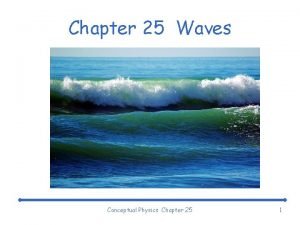Physics Content Review Physics Key stage 4 Waves









- Slides: 9

Physics Content Review Physics - Key stage 4 - Waves Mr Benyohai

Independent practice 1. Why can’t a sound wave travel in a vacuum? 2. Explain why sound waves travel faster through metals than through air. 3. What is the range of human hearing? 4. What is the name given to sounds below the human hearing range?

Independent practice - answers 1. Why can’t a sound wave travel in a vacuum? - Sound is a mechanical wave that requires a medium to travel. A vacuum does not contain any particles so the sound wave is unable to travel. 2. Explain why sound waves travel faster through metals than through air. - The particles in metals are closer together than in air so the vibrations are more easily transmitted between them. 3. What is the range of human hearing? - 20 Hz - 20 k. Hz 4. What is the name given to sounds below the human hearing range? Infrasound

Independent practice 1. What is the frequency of ultrasound? 2. When do ultrasound reflections occur? 3. What needs to be known for ultrasound to be used to determine depth? 4. Ultrasound travels at 1700 m/s through a metal sheet. A pulse is reflected from the opposite side of the sheet and is detected 12 µs after it is produced. How thick is the metal sheet?

Independent practice - answers 1. What is the frequency of ultrasound? - 20 k. Hz 2. When do ultrasound reflections occur? - When there is a change in medium 3. What needs to be known for ultrasound to be used to determine depth? - The speed of the ultrasound 4. Ultrasound travels at 1700 m/s through a metal sheet. A pulse is reflected from the opposite side of the sheet and is detected 12 µs after it is produced. How thick is the metal sheet? - 10. 2 mm

Independent practice 1. The image shows a lens diagram for a concave lens. Identify the two problems with the diagram. 2. A green apple is illuminated with white light. Explain what colour the apple will appear. 3. What three things may happen when a wave meets a material interface. 6 Image Object F

Independent practice - answers 1. The image shows a lens diagram for a concave lens. Identify the two problems with the diagram. - The parallel ray has not passed through the principal focus. The symbols used for a concave lens are incorrect 2. A green apple is illuminated with white light. Explain what colour the apple will appear. - Green. The green light is reflected but all the other colours are absorbed 3. What three things may happen when a wave meets a material interface? Reflection, absorption and transmission. 7 Image Object F

Independent practice 1. Define a black body. 2. What will happen to the temperature of an object if the rate of radiation absorption is greater than the rate of emission? 3. List the seven regions of the electromagnetic spectrum from long wavelength to small wavelength. 4. As the temperature of an object increases what two things happens to the distribution of radiation emitted? 8

Independent practice - answers 1. Define a black body. - A perfect emitter and absorber of electromagnetic radiation 2. What will happen to the temperature of an object if the rate of radiation absorption is greater than the rate of emission? - Its temperature will increase 3. List the seven regions of the electromagnetic spectrum from long wavelength to small wavelength. - Radio wave, microwaves, infrared, visible light, ultraviolet, x-rays, gamma rays 4. As the temperature of an object increases what two things happens to the distribution of radiation emitted? - The intensity of all wavelengths increases and peak wavelength moves to smaller wavelengths. 9
 Vibrations and waves concept development 25-1
Vibrations and waves concept development 25-1 Lesson 1 waves answer key
Lesson 1 waves answer key Similarities of mechanical waves and electromagnetic waves
Similarities of mechanical waves and electromagnetic waves Longitudinal vs transverse wave
Longitudinal vs transverse wave A matter in which waves can travel and transfer energy
A matter in which waves can travel and transfer energy Similarities of mechanical and electromagnetic waves
Similarities of mechanical and electromagnetic waves The wave chapter 13
The wave chapter 13 Sound waves longitudinal waves
Sound waves longitudinal waves What is a semiconductor used for
What is a semiconductor used for Mechanical waves and electromagnetic waves similarities
Mechanical waves and electromagnetic waves similarities

















